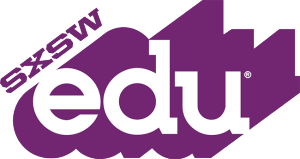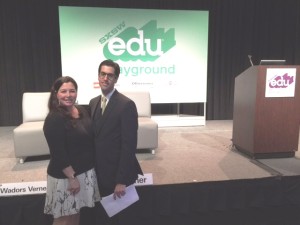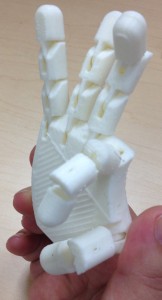At the recent 2016 South by Southwest conference in Austin, Texas, Benetech teamed up with the American Library Association (ALA) to present a session titled: “No More Yoda Heads: 3D printing 4 Diverse Learners.” Lisa Wadors Verne, Benetech Program Manager of Education Research and Partnerships, and Charlie Wapner, an information policy analyst for the ALA Office for Information Technology Policy, discussed ways in which the education community – including libraries, museums, and schools – can leverage 3D printing to create learning opportunities for students with print and other disabilities.
Research suggests that 3D objects are important for learning and reinforcing complex spatial concepts  that are difficult to convey or explore in any other way (e.g., cells and DNA). Although many schools have access to 3D printing technology, many machines are underutilized and used to print novelty items. In Lisa and Charlie’s session, attendees learned about new collaborations with libraries and museums to help support teachers in providing multimodal access to complex STEM topics as well as utilizing student talent to create innovative learning tools.
that are difficult to convey or explore in any other way (e.g., cells and DNA). Although many schools have access to 3D printing technology, many machines are underutilized and used to print novelty items. In Lisa and Charlie’s session, attendees learned about new collaborations with libraries and museums to help support teachers in providing multimodal access to complex STEM topics as well as utilizing student talent to create innovative learning tools.
An often overlooked piece of the potential of 3D printers in education is their power to create a level playing field for learners of all abilities. “3D printers have the capacity to yield tremendous progress in the field of education,” says Lisa. “When educators and technologists speak of this capacity, they often point to the power of 3D printing to facilitate connected learning, demystify complex STEM topics, and build critical skills for the modern workforce. Our session is devoted to exploring the world of 3D printing and how it can help open the world of learning to all students.”
 In their session, Lisa outlined how 3D-printed learning tools can animate the learning process for students who have print, learning, and physical impairments. (If you’re not quite sure what that means, think about how a 3D-printed double helix or H2O molecule might bring science to life for a visually-impaired student.) Charlie described why libraries, as creative, non-judgmental spaces, are the ideal institutions to support the development of assistive technologies through the use of 3D printing technology.
In their session, Lisa outlined how 3D-printed learning tools can animate the learning process for students who have print, learning, and physical impairments. (If you’re not quite sure what that means, think about how a 3D-printed double helix or H2O molecule might bring science to life for a visually-impaired student.) Charlie described why libraries, as creative, non-judgmental spaces, are the ideal institutions to support the development of assistive technologies through the use of 3D printing technology.
After the presentation was over, several individuals wanted to learn more about Benetech’s 3D printing initiative to create educational equity. Lisa summarized the learning from a convening last summer that brought together practitioners from key institutions and industry to develop ideas for using 3D printers to put all learners on an even footing. In addition, the presenters urged attendees to visit the DIAGRAM Center, a Benetech initiative that is exploring new technologies for creating tactiles and tactile experiences that offer revolutionary ways of conveying spatial information. Says Charlie, “No one else is doing what Benetech is doing in the 3D printing space.”
In response to the inquiries about the role today’s libraries play in their communities, Charlie reiterated that libraries are one-stop community hubs, replete with informational and digital resources that people of all ages and backgrounds can use to engage in creative learning, seek government services, pursue entrepreneurial opportunities, and a great deal more.
that libraries are one-stop community hubs, replete with informational and digital resources that people of all ages and backgrounds can use to engage in creative learning, seek government services, pursue entrepreneurial opportunities, and a great deal more.
Benetech would like to thank Charlie and the ALA for their worthwhile collaboration at SXSWedu and support of our Global Literacy program initiatives.
To learn more about the SXSW experience from Charlie’s perspective, read his blog post on the District Dispatch, the official ALA website in Washington, DC.

Be First to Comment